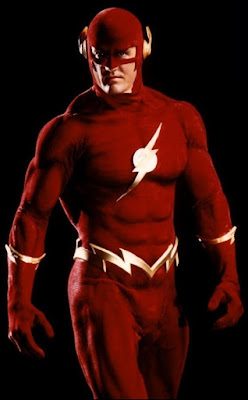Bilson and De Meo chose The Flash. There was a problem though. DC wanted to promote Wally West as The Flash because, by 1990, Barry Allen, the 2nd Flash, had died in the Crisis On Infinite Earth's saga that closed out the Bronze Age. Wally was formerly Kid Flash, Barry's sidekick, but the producers hated Wally as The Flash. So, compromise was reached. This new show would use Barry Allen as The Flash and combine the character with aspects of Wally. Barry Allen, the police scientist, would have Wally's red hair and need to eat a lot of food to maintain his metabolism. They also wanted the show to be dark, urban and dramatic. They used the Batman movie as a template for how the show would look. Art-deco buildings and vintage cars were merged with current technology to give the series a timeless quality.
The search was on for a great cast. Bilson and De Meo tested more than fifty actors for the lead role. Eventually, John Wesley Shipp, an Emmy award-winning soap opera star, was cast. He didn't know anything about comic books or The Flash and had to do a lot of research. At first, when he was told about the project, he declined, as he didn't want to be seen in tights. After reading the script, he was impressed enough to audition. Shipp has a lot of charm as Barry Allen and plays the role with such confidence and sincerity that you constantly root for him. This is how a superhero should look and act on screen.
Amanda Pays was cast as Tina McGee, a scientist and love interest for Barry who was then Wally's girlfriend in the comics. Alex Désert played Julio Mendez, a character created for the show, that served as Barry's lab partner. While both Amanda Pays and Alex Désert are fun to watch, they lack the charm of a well-rounded cast when compared to later superhero shows like Lois and Clark but, if given enough time to develop I'm sure they would have been stellar.
One of the special and most remembered things about this show is the Trickster cameos, played famously by Mark Hamill, before he became even more famous for his role as The Joker on Batman: The Animated Series. Here, Mark Hamill has fun in his role as the psychotic villain and, by his own admission, he even lobbied for the part. The Trickster episodes are some of the most fun episodes of the series entire run.
 |
| Famed comics artist and Rocketeer creator, Dave Stevens, drew the concept art for the Flash costume. |
So, after enlisting award winning costumer Robert Short, famous for his work on Star Trek: The Motion Picture (1979), a prototype costume was created out of latex. They used various techniques such as flocking, sculpting, and painting to create a suit with a unique muscular texture. Eight suits were made at a total cost of nearly $1 million USD. The suit itself was very hot and claustrophobic to wear. John Wesley Shipp lost some weight in the suit at first and considered seeing a shrink for his claustrophobia until accommodations were made. Cooling vents were installed in the suit to keep the actor cool and his time in the suit was more limited. As difficult and expensive as it was to bring the Flash suit to screen, it looks amazing for 1990 and, in my opinion, remains one of the best superhero costumes ever produced for any production.
After six weeks of filming (and nearly $6 million), the 90-minute TV pilot debuted on September 20th, 1990 and was a resounding success. The show ran for a season but after twenty-two episodes, the series was not renewed for a second season. That's most likely because of it being an effects heavy show, expensive to produce, and it faced stiff competition in the form of The Simpsons and The Cosby Show. It's a real shame that this show wasn't renewed because, by all accounts, the second season was supposed to be even more effects heavy with a bigger budget. The season two pilot was supposed to be a two-part feature that had multiple classic rogues of The Flash in a plot to take down the Scarlet Speedster.
Once the dust settled, multiple episodes of this series were edited together for three direct-to-video movies. The Flash (1990), The Flash II: Revenge of The Trickster (1991), and The Flash III: Deadly Nightshade (1992). Later still, John Wesley Shipp (and a few of his fellow cast members) returned to the new Flash show in 2014. Here, Shipp played Barry Allen's dad, Jay Garrick (the Golden Age Flash), and even cameoed as his own character, The Flash, in a crossover episode with Arrow and Supergirl. This show is fondly remembered by many older superhero fans and Flash fans. For fans of the newer Flash series, this might be a welcomed surprise. It's a fun watch with a lot of heart. Highly recommended.






No comments:
Post a Comment